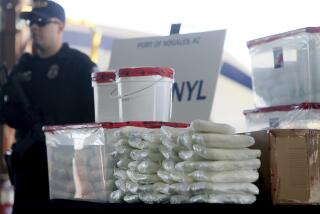Editorial: Thousands are dying. The president needs to do more than bluster on the opioid crisis

President Trump’s long-anticipated announcement addressing the epidemic of opioid addiction was — ah, how to put this diplomatically — more talk than walk. It was good to hear Trump frame the problem as a public health emergency, not a criminal justice one — a departure from the bad old “war on drugs” days. But there just wasn’t much to his announcement other than vague commitments, troubling insinuations and missed opportunities.
Still, it was a first step in what will necessarily be a long journey. As Trump correctly pointed out, the epidemic that’s killing about 175 Americans a day took years to grow to its current proportions. It cannot be ended overnight, and there will be more opportunities for the president to get his opioid message and policy right. Here are some of the specifics we’d like to hear from the president in the days ahead:
There will be money. The most disappointing aspect of last week’s “public health emergency” declaration was that it did not come with any funding commitment. Nor did the president offer any specifics on how the country will pay for what it will take to “liberate our communities from this scourge of drug addiction,” as he put it Thursday. So Trump’s next step should be to urge (and by “urge,” we mean “twist some arms”) Congress to set aside money to fund expanded drug treatment programs and efforts to avert overdose deaths.
At the very least, Trump could vow to help particularly hard-hit communities buy naloxone, a nasal spray that reverses drug overdoses, so they don’t have to consider rationing the life-saving drug. An estimated 64,000 people died from drug overdoses last year alone. Imagine the lives that could be saved if just $100 million of what might otherwise be spent on, say, an ill-conceived border wall was redirected to buy naloxone kits and train people to use them?
There just wasn’t much to Trump’s opioid addiction announcement other than vague commitments, troubling insinuations and missed opportunities.
Medicaid will be protected. It’s perplexing that Trump is promising to fight the “plague” of opioid addiction even as he is working to slash Medicaid funding. Medicaid, which provides healthcare to disabled and low-income adults and children, is the single most important source of financing for opioid drug treatment. Reversing the Medicaid expansion under the Affordable Care Act, as Trump and congressional Republicans have been trying to do, would seriously undermine the president’s action plan.
We won’t repeat the mistakes of the past. That means not doubling down on the failed war on drugs or dusting off the “Just say no” campaign. Public awareness campaigns can be effective, but the “massive advertising campaign to get people, especially children, not to want to take drugs in the first place” pledged by Trump sounds worryingly like something out of 1985. And for those who got hooked on prescription painkillers after severe injuries or illness, it’s hard to see how an ad campaign would be much help.
Everything is on the table. Trump said he would be “pushing the concept of nonaddictive painkillers very, very hard” and has directed the National Institutes of Health to work with pharmaceutical companies to develop nonaddictive pain medication. That’s not a bad idea, but why not study one potential alternative that is right under our nose: marijuana? Research has suggested that cannabis could be effective in pain management, even for chronic pain. But because marijuana is an illegal substance under federal law, it’s difficult for researchers to study its potential as an alternative. With more than half the states in the country allowing medicinal use of marijuana, it seems like an ideal time to allow scientific research into its pain-killing properties.
We’re going to interrupt the supply chain. The supply of addicts, that is. While efforts have focused on stopping the supply of illegal fentanyl, which is particularly deadly, we also need a better understanding of what’s driving the increase in prescription-opioid addicts — which now number about 11 million — so that we can do more to prevent new ones.
We could go on, but there’s not enough room here to lay out the many specific and significant actions Trump could take. For example, he could promise to appoint a drug czar with a background in both treatment and enforcement (and certainly no ties to the pharmaceutical industry). He could support efforts to limit opioid prescriptions to seven days except in cases of chronic pain. He could push for the development of permanent drug take-back programs so that unused opioid prescriptions don’t end up for sale on the street.
No doubt there will be other smart ideas among the final recommendations released next week by the President’s Commission on Combating Drug Addiction and the Opioid Crisis. That would be an ideal time for Trump to show that his response to opioid epidemic is more than just words.
Follow the Opinion section on Twitter @latimesopinion and Facebook
More to Read
A cure for the common opinion
Get thought-provoking perspectives with our weekly newsletter.
You may occasionally receive promotional content from the Los Angeles Times.






